![]()
![]()
![]()
Use LEFT and RIGHT arrow keys to navigate between flashcards;
Use UP and DOWN arrow keys to flip the card;
H to show hint;
A reads text to speech;
42 Cards in this Set
- Front
- Back
|
All organisms must exchange substances with its environment |
Ultimately occurs at the cellular level (crossing plasma membrane) Unicellular organisms, it’s easy. Think of flat worm whose cells are all exposed to environment
|
|
|
Multicellular organisms and gas exchange |
Gills: exchange system in animals (O2 diffuses from water into blood vessels and CO2 diffuses into the water) Internal transport and gas exchange are functionally related in most animals |
|
|
Diffusion |
Small molecules can move btw cells and their surroundings Only efficient over small distances bc the it takes time to diffuse is equal to square area of distance (ie: takes 1sec of glucose to diffuse 100 microm, it takes 100 seconds to diffuse 1 mm, 3 hours to diffuse 1 cm) |
|
|
2 body plan options for gas exchange |
1. Cells exchange directly (thin flat worms or thin animals) Or 2. Cells exchange materials with the environment via fluid-filled circulatory system (all animals) |
|
|
Gastrovascular cavities |
In animals that lack circular system Functions in both digestion and distribution of substances throughout the body Body wall of cavity is only 2 cells thick |
|
|
Circulatory systems |
Contains: Circulatory fluid, a set of interconnected vessels, a muscular pump, the heart Connects fluid that surrounds cells with the organs that exchange gases, absorb nutrients, and dispose of waste Can be open or closed |
|
|
Open circulatory system |
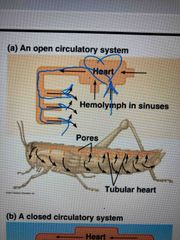
Contain hemolymph (combo fluid of blood and interstitial) Bathes organs directly Insects, Arthropods, moluscs |
|
|
Closed circulatory system |
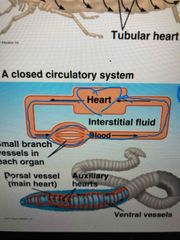
Blood confined to vessels and is distinct from interstitial fluid Vertebrates, cephalopods, annelids |
|
|
Adaptive and evolution pros/cons |
Closed is more costly to maintain so higher metabolic demand but higher pressure inside so it’s more effective Open good for hard outer covering animals to help maintain pressure. Lower pressure is less costly to maintain. Some insects can use that pressure from the system to move their body (spiders and legs) |
|
|
Cardiovascular system |
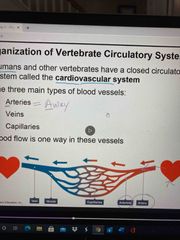
Humans and other vertebrates have closed systems Blood flows in one direction in vessels |
|
|
3 main types of blood vessels |
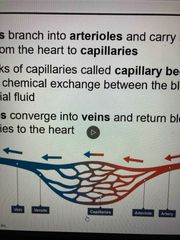
1. Arteries: away from heart, biggest and branch into arterioles, beach into capillaries 2. Veins: capillaries merge to venule, then merge to veins, towards heart 3. Capillaries: infiltrate all tissue Branches from biggest to small so they reach all cells in the body |
|
|
Capillary beds |
Sites of chemical exchange btw blood and interstitial fluid |
|
|
Portal vein |
Carry blood btw capillary beds ie: hepatic portal vein (liver): carries blood from capillary beds in small intestine, stops and in liver. |
|
|
Heart chambers |
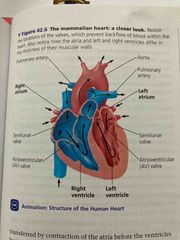
Vertebrates contain 2 or more chambers Blood enters through the atria and is then pumped out through ventricles |
|
|
Single circulation |
Blood leaving the heart passes through 2 capillary beds before returning 2 chambered heart with 1 Pump through artery, 2 cap beds, then returns through vein. Low pressure system, moving through water helps pump blood, needs less energy Bony fishes, rats, and sharks |
|
|
Double circulation |
2 pumps, 4-chambered heart Oxygen-poor and oxygen-rich blood are pumped separately from the right and left sides of heart Helps to reestablish pressure, maintains pressure in systemic circuit Amphibians, reptiles, mammals and birds |
|
|
Systemic circuit |
Oxygen-rich blood delivers oxygen through this |
|
|
Differences in amphibians |
Not fully divided in heart so they can shut off blood to the lungs when not using lungs Also have pulmocutaneous circuit where they can get oxygen from their lungs and skin |
|
|
Evolution variation |
Intermittent breathers: long periods without gas exchange or gas exchange from another tissue (skin) Amphibians: 3 chambered 2 atria 1 ventricle Most reptiles have 3 chambered with partially divided incomplete septum |
|
|
Mammals circulatory system |
4 chambered heart, 2 atria, 2 ventricles Mammals and birds are endotherms and require O2 than ectotherms (convergent evolution-developed 4 chamber heart but different ancestors) |
|
|
Circulation |
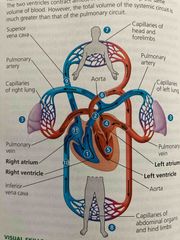
Right ventricle sends blue blood to capillary beds in lungs via pulmonary arteries In lungs, loads O2 and unloads CO2 and continues on pulmonary artery Now red blood, enters heart through left atrium, then left ventricle which pumps it out through the aorta to the body tissues (capillary beds) Coronary arteries get blood from aorta first Blood returns to heart the through superior (top) or inferior (bottom) vena cava Goes into right atrium and then right ventricle to start again pumping about 5 L of blood/min at 72 beats/min |
|
|
Heart |
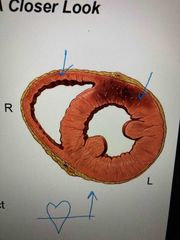
Size of clenched fists made of cardiac muscle 2 atria have thin walls and serve as collection chambers for blood returning to the heart Ventricles have thick walls so they can contract |
|
|
Cardiac cycles |
Contract and relax in rhythmic cycle Cells will continue to contract in a dish Systole: contraction/ pumping Diastole: relaxation/filling |
|
|
Cardia cycle |
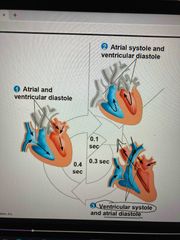
1. Atrial and ventricular diastole (.4 sec) 2. Atrial systole and ventricular diastole (.1 sec) allows to squeeze all blood out 3. Ventricular systole and atrial diastole (.3) |
|
|
Heart rate |
Number of beats per minute Typical resting is about 72 beats/min |
|
|
Stroke volume |
Amount of blood pumped into a single contraction About 70mL |
|
|
Cardiac output |
Volume of blood pumped into the systemic circulation per minute Depends on both the heart rate and stoke volume (5L of blood/min) This can change depending on temperature (1 C can increase 10 beats/min) Excessive can increase rate |
|
|
4 one-way valves |
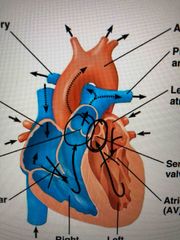
Prevent blood going back. Atrioventricular valves (AV) also know as tricuspid and mitral) atrium and ventricul Semilunar valves (aortic and pulmonic) control blood flow to aorta and pulmonary artery |
|
|
Lub dub sound |
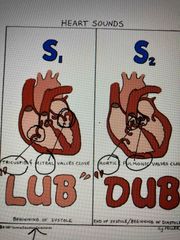
Lub: AV valves close and blood hits against it Dub: semilunar valves closing |
|
|
Heart murmur |
Backflow of blood through a defective valve |
|
|
Autorythmic |
Contract without any signal from nervous system Take out of dish and it contracts on own |
|
|
Electrocardiogram (ECG or EKG) |
Recorded impulses that travel to skin from the cardiac cycle |
|
|
Sinoatrial Node (SA) |
Pacemaker Sets rate and timing at which cardiac muscle cells contract Located in wall of right atrium Intercollated disc in cardiac cells have gap junctions that allow for electrical spread |
|
|
First step is EKG |
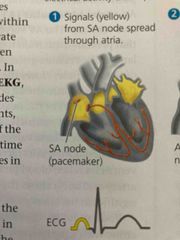
Signal from SA node spread through atria Atrial systole |
|
|
2nd step of EKG |
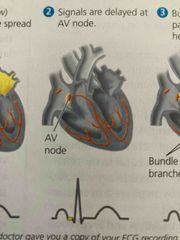
Signals are delayed at atriovebtricular node .1 second delay This makes sure all blood is out of atrium |
|
|
3rd step of EKG |
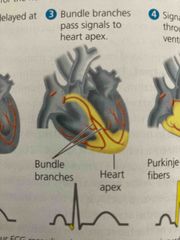
AV node travel to purkinje fiber (specialized muscle fiber) to apex of heart |
|
|
4th step of EKG |

Signal starts squeezing from bottom of ventricles and moves up to squeeze blood up and out Ventricular systole |
|
|
Regulation of pacemaker |
Nervous system: sympathetic (fight or flight) and parasympathetic (rest and digest) Sympathetic speeds up pacemaker Para slows down pacemaker Also regulates by hormones and temp (fever: heart rate increases 10 beats, per min per degree C) |
|
|
Histology of heart: wall has 3 layers |
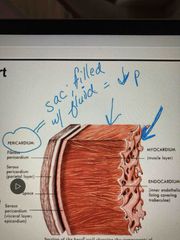
1. Endocardium (inner layer), epithelial, smooth 2. Myocardium: middle layer 3. Epicardium: external layer, loose connective tissue, fibers, adipose to cushion heart Pericardium: save filled with fluid prevents friction |
|
|
Cell layers of heart |
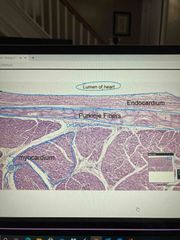
Lumen Endocardium: smooth epithelial Myocardium Purkinje fiber: special fibers still cardiac tissue but different |
|
|
2 types of organic precursors from food needed |
Organic carbon and nitrogen Serves as rates materials for the synthesis |
|
|
4 Clases of essential nutrients |
Amino acids Fatty acids Vitamins Minerals |

